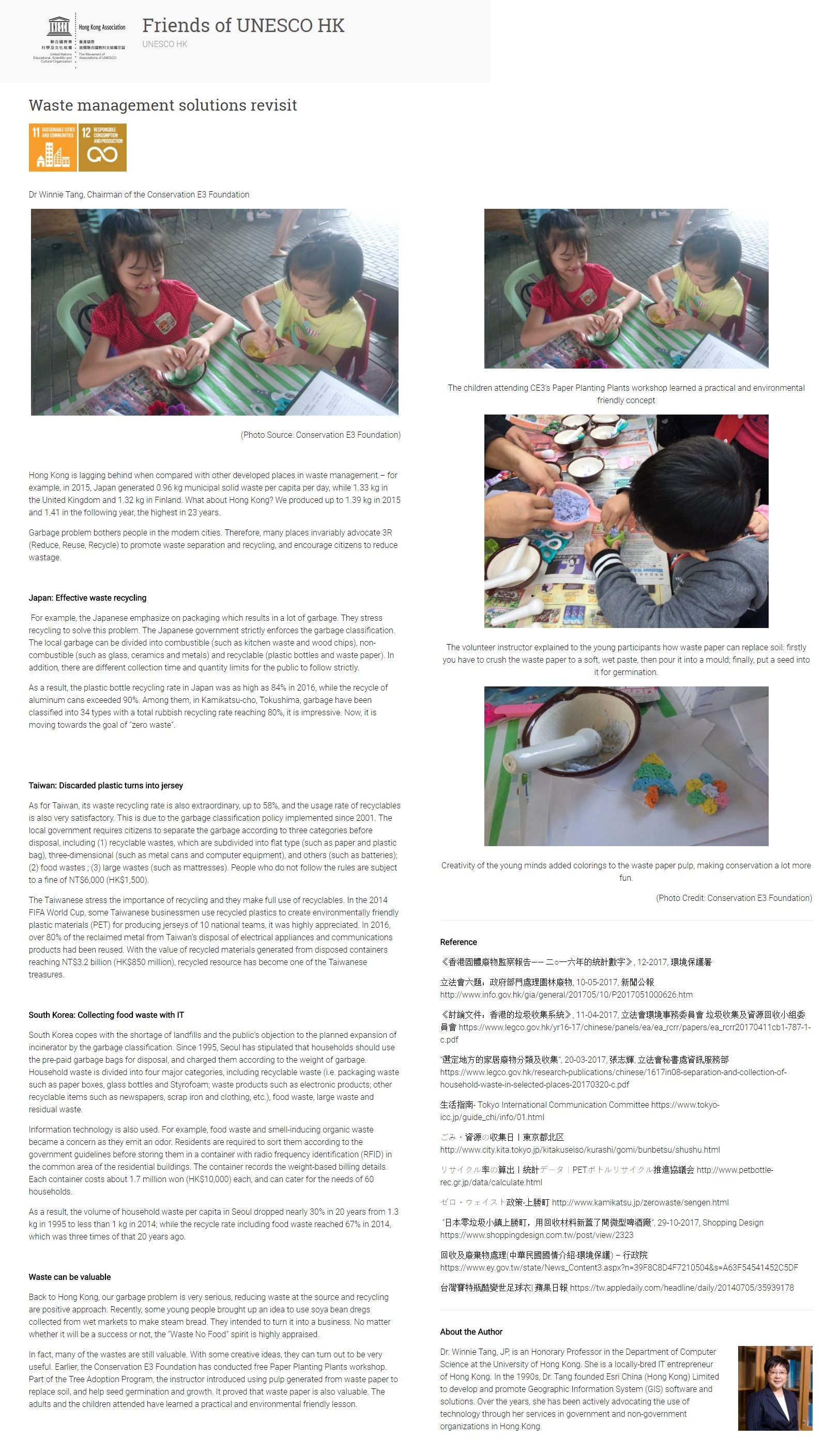網上版請按此

Waste management solutions revisit
Hong Kong is lagging behind when compared with other developed places in waste management – for example, in 2015, Japan generated 0.96 kg municipal solid waste per capita per day, while 1.33 kg in the United Kingdom and 1.32 kg in Finland. What about Hong Kong? We produced up to 1.39 kg in 2015 and 1.41 in the following year, the highest in 23 years.
Garbage problem bothers people in the modern cities. Therefore, many places invariably advocate 3R (Reduce, Reuse, Recycle) to promote waste separation and recycling, and encourage citizens to reduce wastage.
Japan: Effective waste recycling
For example, the Japanese emphasize on packaging which results in a lot of garbage. They stress recycling to solve this problem. The Japanese government strictly enforces the garbage classification. The local garbage can be divided into combustible (such as kitchen waste and wood chips), non-combustible (such as glass, ceramics and metals) and recyclable (plastic bottles and waste paper). In addition, there are different collection time and quantity limits for the public to follow strictly.
As a result, the plastic bottle recycling rate in Japan was as high as 84% in 2016, while the recycle of aluminum cans exceeded 90%. Among them, in Kamikatsu-cho, Tokushima, garbage have been classified into 34 types with a total rubbish recycling rate reaching 80%, it is impressive. Now, it is moving towards the goal of “zero waste”.
Taiwan: Discarded plastic turns into jersey
As for Taiwan, its waste recycling rate is also extraordinary, up to 58%, and the usage rate of recyclables is also very satisfactory. This is due to the garbage classification policy implemented since 2001. The local government requires citizens to separate the garbage according to three categories before disposal, including (1) recyclable wastes, which are subdivided into flat type (such as paper and plastic bag), three-dimensional (such as metal cans and computer equipment), and others (such as batteries); (2) food wastes ; (3) large wastes (such as mattresses). People who do not follow the rules are subject to a fine of NT$6,000 (HK$1,500).
The Taiwanese stress the importance of recycling and they make full use of recyclables. In the 2014 FIFA World Cup, some Taiwanese businessmen use recycled plastics to create environmentally friendly plastic materials (PET) for producing jerseys of 10 national teams, it was highly appreciated. In 2016, over 80% of the reclaimed metal from Taiwan's disposal of electrical appliances and communications products had been reused. With the value of recycled materials generated from disposed containers reaching NT$3.2 billion (HK$850 million), recycled resource has become one of the Taiwanese treasures.
South Korea: Collecting food waste with IT
South Korea copes with the shortage of landfills and the public's objection to the planned expansion of incinerator by the garbage classification. Since 1995, Seoul has stipulated that households should use the pre-paid garbage bags for disposal, and charged them according to the weight of garbage. Household waste is divided into four major categories, including recyclable waste (i.e. packaging waste such as paper boxes, glass bottles and Styrofoam; waste products such as electronic products; other recyclable items such as newspapers, scrap iron and clothing, etc.), food waste, large waste and residual waste.
Information technology is also used. For example, food waste and smell-inducing organic waste became a concern as they emit an odor. Residents are required to sort them according to the government guidelines before storing them in a container with radio frequency identification (RFID) in the common area of the residential buildings. The container records the weight-based billing details. Each container costs about 1.7 million won (HK$10,000) each, and can cater for the needs of 60 households.
As a result, the volume of household waste per capita in Seoul dropped nearly 30% in 20 years from 1.3 kg in 1995 to less than 1 kg in 2014; while the recycle rate including food waste reached 67% in 2014, which was three times of that 20 years ago.
Waste can be valuable
Back to Hong Kong, our garbage problem is very serious, reducing waste at the source and recycling are positive approach. Recently, some young people brought up an idea to use soya bean dregs collected from wet markets to make steam bread. They intended to turn it into a business. No matter whether it will be a success or not, the “Waste No Food” spirit is highly appraised.
In fact, many of the wastes are still valuable. With some creative ideas, they can turn out to be very useful. Earlier, the Conservation E3 Foundation has conducted free Paper Planting Plants workshop. Part of the Tree Adoption Program, the instructor introduced using pulp generated from waste paper to replace soil, and help seed germination and growth. It proved that waste paper is also valuable. The adults and the children attended have learned a practical and environmental friendly lesson.
Dr. Winnie Tang
Chairman of the Conservation E3 Foundation